Today's tutorial takes a look at how you can create a workflow using the same keyword for multiple actions.
Generally, it's preferable to have unique keywords, so that you can type it, hit the Return key and launch the workflow. However, when you have a set of similar actions to perform that you don't use everyday, it can be a useful way to group them together. Remembering numerous rarely-used keywords can be inconvenient when you have a memory like a sieve!
For example, I use Safari as default browser, but need to view sites that requires Flash in Chrome, so I first set up a workflow that launches the Fitbit website in Chrome. I then added two more actions to launch different pages to log activities and sleep when I've forgotten to wear my wristband. (What did I say about being forgetful?)
As you can see, the keyword brings up four items; Three workflow entries and the Fitbit Connect app. The most frequently used result (the website) appears at the top of the list, but the other actions are also conveniently available for occasional use.
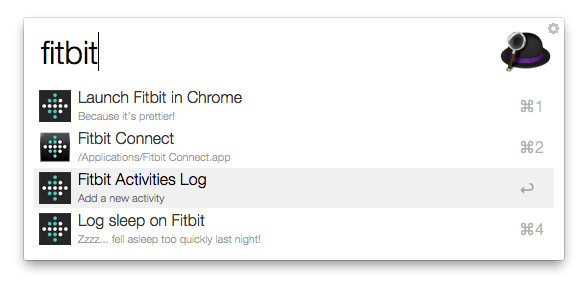
To set up this workflow, I simply connected each action to a separate, but identical keyword. If I had connected the three "Open URL" objects to a single keyword, Alfred would have presented me with a single results, and all three pages would have launched at the same time when I hit Return (which can also be useful, but wasn't the objective here).
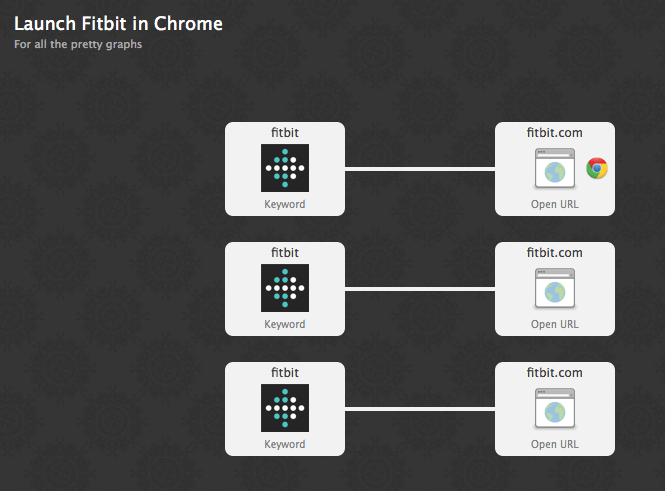
In this case, all keywords except for the Fitbit Connect application are part of the workflow, but you could also use the keyword for a custom search if the website had a searchable documentation section.
Enjoyed this short tutorial? You'll find many more in the Tutorials section of the blog.
Alfred v2.4 officially brings in OS X Yosemite compatibility and theming improvements, as well as some general improvements and bug fixes.
While Alfred has been working fine on Yosemite since the first OS X 10.10 beta, this latest release adds improvements and fixes the minor quirks some users have experienced in Yosemite.
Theming Improvements
We've made loads of theming improvements and have added two gorgeous Yosemite-style themes to the default selection of themes, with a light and a dark version using Helvetica Neue Light for a swish fresh look.
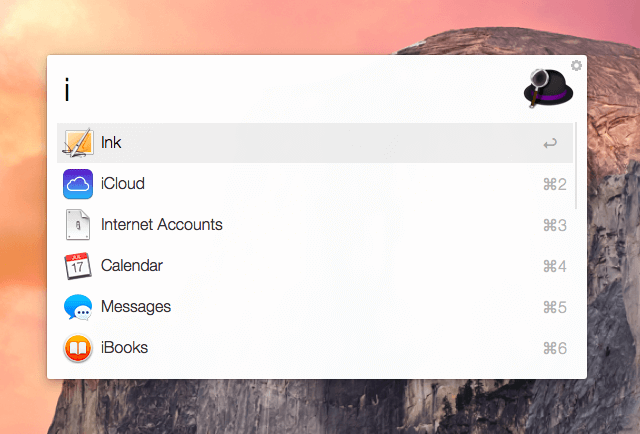
If you're a Powerpack user, you can customise the themes to get a slick semi-transparent background by turning down the opacity of the background and setting the new window blur option to medium in the Appearance Options.
Amongst the many other theming improvements, you can also now change when to show the result subtext, allowing you better control over how minimalist your theme is; Show the result subtext for the selected row or only for alternative actions.
Fuzzy Matching for File System Navigation
This new option makes browsing the file system even easier by introducing fuzzy matching; While browsing your file system navigation results, "CS" will bring up ColorSnapper or "GC" for Google Chrome. This setting is on by default and matches file results more loosely for a more natural search.
If you preferred the old bash/shell style navigation, you can turn off fuzzy matching in Alfred's Features > File Search > Navigation preferences.
Improvements to Workflows
Amongst the many workflow improvements, you'll find some useful new alfred_ environment variables when running scripts, which provide commonly required Alfred information. We've included more details on these variables in this support Knowledge Base.
We've also added support for proxies (http_proxy and https_proxy) and the proxy exception list. You can enable proxy support in Alfred's Advanced preferences.
Many more improvements and bug fixes
Have a look at the change log for the full list of improvements and fixes. And don't forget to update to v2.4 in-app through the Update tab or download it from our website.
There's something almost magical about Alfred learning to predict the result you want most when you type a few characters; It's the perfect and easy way to search for apps, folders, contacts and other results that live on your Mac.
However, sometimes, you need to do a quick web search. The usual way to do this would be to type "wiki" followed by your search term to launch the relevant Wikipedia page, or type "youtube" to search YouTube. But there IS an even quicker way to search your most-used sites: Fallback searches. They're the list of search options you see when you search for a keyword that doesn't match a result on your local Mac.
The default fallback searches are Google, Wikipedia and Amazon, as these are the most commonly used web searches. If you're a Powerpack user, you can customise these to your favourite sites or actions instead.
Here are my fallback searches; Wikipedia, the OS X dictionary, YouTube, Amazon and Etsy. (and yes, I'm searching for beer)
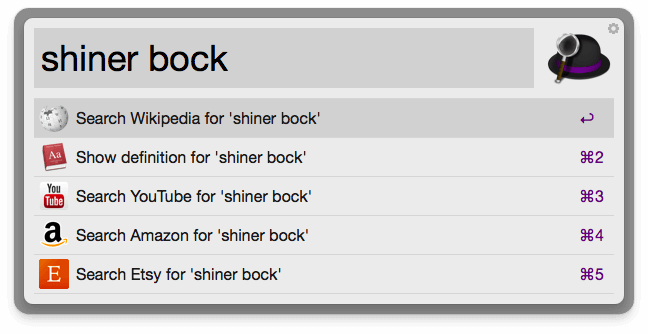
You can change your fallback searches in Alfred's preferences under Features > Default Results, where you'll see a "Fallback Results" button. Use the + button to add web searches, custom searches and workflow triggers. You can then drag and drop them to reorder them.
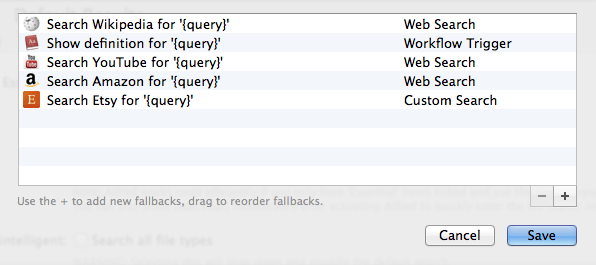
My fallbacks are a mix of default web searches (Wikipedia, YouTube and Amazon), custom searches (Etsy) and workflow triggers (Dictionary search).
Create custom searches for your favourite websites that aren't part of Alfred's default web searches, or create fallback triggers in workflows for actions like "Show definition for {query}".
Once you've arranged these in the order you want, your fallback searches will appear anytime you type a keyword where Alfred doesn't find a local search result! :)
Enjoyed this post? We've published more tips and tricks on making the most of Alfred.
Over the past year, we've rolled out our corporate licensing scheme to many companies who love Alfred. Providing staff members with the Powerpack through this license scheme allows you to create workflows for in-house use without having to worry whether each team member has already bought a license.
Whether you're a designer, developer, copywriter or anyone where efficiency plays a part in what you do, you'll benefit from the advanced features the Powerpack brings you. From workflows and custom hotkeys to Clipboard History and 1Password bookmarks integration, there are so many ways to improve the way you manage your everyday work tasks.
How does the corporate license differ from standard licenses?
- Available to business teams exclusively
- Discount ranging from 10% to 50% depending on the number of volume of seats purchased
- Company-wide license means that there is no need to juggle individual license codes for each staff member
If you think your team would benefit from using the Powerpack, contact us for more details on corporate licensing. What could be better than getting your boss to buy you a Powerpack license? :)
Following the release of OS X Yosemite Preview 4 as a public beta, we're bringing forward the first Alfred v2.4 release. This build has better support for saving Alfred's preferences, which were affected by a few changes introduced in Preview 4, as well as a whole host of amazing new improvements including two brand new Yosemite themes.
If you're using Yosemite Preview 4, we would love for you to help us test this build. Keep in mind that this is a development build and is essentially untested, but we've been using it over the past few weeks and it's perfectly stable.
You can update to the latest pre-release in-app or download the beta Alfred v2.4 build 277 directly to take advantage of these improvements. Once the build has been thoroughly tested, we'll put it out to general release.
You can now update to the latest release in app or download Alfred directly from alfredapp.com to take advantage of these improvements.
You can see what's new in Alfred v2.4 so far in the change log.





